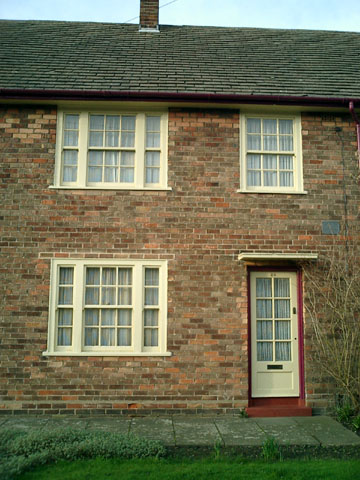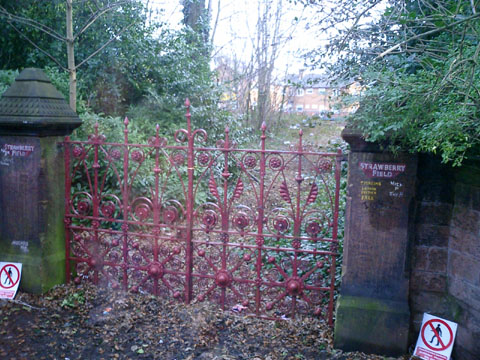SAVE in dramatic bid to list Beatles Houses
As bulldozers close in on Ringo Starr's childhood home, SAVE and the Merseyside Civic Society appeal for the immediate group listing of Beatles Houses.
SAVE has joined forces with the Merseyside Civic Society (MCS) to apply for the listing of 9 Madryn Street, Liverpool, the birthplace and childhood home of the Beatles drummer Ringo Starr, together with five other buildings in Liverpool with intimate connections to the Beatles. The appeal comes in response to the City council’s bid to demolish Ringo’s birthplace in the Welsh Streets area of the city. Currently, none of the former Beatles homes in the city are listed, although two houses are owned and operated by the National Trust.
9 Madryn Street, where Ringo was born and lived until he was four, is earmarked for clearance as part of the government’s controversial Housing Market Renewal (Pathfinder) Initiative, described by the Urban Task Force as a 'crude, insensitive and wasteful' return to mass housing clearance, and criticised as ‘high risk’ by the National Audit Office. The programme has already resulted in the demolition of large swathes of northern towns and cities, leaving communities decimated and whole neighbourhoods destroyed.
Nowhere has this insensitivity and waste been more apparent than on Merseyside where entire districts of the well planned Victorian and Edwardian inner suburbs of Liverpool, a UNESCO World Heritage city, have been laid waste by blight imposed at immense public expense. Edge Hill, Toxteth, Kensington and Anfield have been subject to long term land banking, with communities, businesses and urban fabric forced to make way for acre after acre of vacant lots.
SAVE and MCS are calling for the immediate listing of Madryn Street, together with 10 Admiral Grove, Ringo’s subsequent childhood home; 12 Arnold Grove, the birthplace of George Harrison; Mendips, Menlove Avenue, where John Lennon lived from 1945 to 1963; 20 Forthlin Road, childhood home of Paul McCartney, and the ornate iron gates and stone piers of Strawberry Field, all that remains of the house and gardens which inspired one of the Beatles’ most famous songs.
William Palin, Secretary of SAVE says ‘This is a bid for national recognition and statutory protection for a group of buildings which are intimately associated with the four men who, together, became the greatest cultural phenomenon of the 20th century.
‘In 1973, Liverpool’s celebrated Cavern Club, birthplace of the Beatles, was demolished because of a council compulsory purchase order, to make room for a ventilation shaft that was never built. The destruction of Madryn Street would represent another tragic loss and a further assault on the heart and spirit of the city.’
‘It is astonishing and distressing that Liverpool City Council retains such a callous disregard for its cultural heritage, and sad that it should fall to organisations such as SAVE and the MCS to protect and promote buildings within the city that have such huge historic and socio-economic importance.’
Marcus Binney, President of SAVE says ‘From the very start of listing in 1945 the Act provided for listing buildings for their special historic interest as well as their architectural quality. The earliest guidelines for listing specifically mention buildings which are associated in the public mind with famous people. The Liverpool sites associated with the Beatles including their childhood homes are clearly of the strongest interest to the British public as witnessed by the thousands of visitors to the Beatles homes owned by the National Trust’.
MCS planner Jonathan Brown says: ‘20th-century Liverpool and its port helped shape the Beatles phenomenon; in the 21st century their global stardom illuminates Liverpool’s place on the world stage.’
‘The international public have an almighty appetite for sites and buildings associated with the band’s early story, a blessing city authorities have been slow to acknowledge.’
‘If allowed, demolition of their homes and birthplaces will eclipse loss of the Cavern Club as an act of crass cultural vandalism. In fact, it would be far less forgivable, because of what we now know about the importance of music and tourism to economic revival. We appeal to the Secretary of State to stop the bulldozers unleashed by Mr Prescott’.
‘Of course, the listing application is about much more than the birthplaces of four individuals; it is also about protecting the inner city communities of Liverpool from being sold out to narrow developer interests by public officials. The Pathfinder clearances have wiped out swathes of entire historic districts like Edge Hill, Anfield, Bootle and Toxteth; demolition of Beatles’ heritage is just a symptom of the scheme’s indifference to social values beyond land assembly.’
SAVE and the MCS have written to EH to request the listing of the following buildings at Grade II:
9 Madryn Street, Liverpool, L8
The birthplace of drummer Richard Starkey (b. 7.7.1940), best known by his stage name, Ringo Starr (coined when he joined the Beatles in 1962). He lived here until the age of four.
The building is a two-bay, two-up two-down ‘back of pavement’ terraced house in the ‘Welsh Streets’ area of Toxteth, Liverpool developed in the late 19th-century to house migrant Welsh workers, most of whom were employed in the building trades.
The house and the area have been often recalled by Ringo during his career. ‘I was born at Number 9 Madryn Street, Liverpool 8’ are the highlighted first words in his section of the Beatles Anthology, the band's authorised autobiography. And his valedictory solo album Liverpool 8 features the single Liverpool I Love You and the lyric ‘Said goodbye to Madryn Street’. The house is visited daily by coach tours on the city’s Beatles trail, and plans for its demolition have attracted international press attention.
10 Admiral Grove, Liverpool, L8
Ringo’s single Liverpool I Left You also referred to this house where he lived after moving from Madryn Street: ‘Liverpool I left you, said goodbye to Admiral Grove’. Two-bay, two-up two-down ‘back of pavement’ terraced house.
12 Arnold Grove, Liverpool, L15
The birthplace of Beatles guitarist George Harrison (b. 25.2.1943 d. 29.11.2001). He lived here for the first six years of his life. A two-bay, two-up two-down ‘back of pavement’ terraced house close to the iconic Penny Lane.
This semi-detached house, built in 1933, was the childhood home of John Lennon (b. 1940) from 1945-1963. It is recorded with a blue EH plaque. Lennon lived at Mendips with his Aunt Mimi after the separation of his parents. He was here during the formative Beatles years, and a number of early songs were composed at Mendips with Paul McCartney. It is now owned by the National Trust and, like Forthlin Road, is a successful tourist attraction.
20 Forthlin Road, Liverpool, L24
This semi-detatched post-war council house in Allerton was the childhood home of Paul McCartney (b. 1942) from 1955. It is owned by the National Trust and is a successful tourist attraction. John Lennon and Paul McCartney are known to have composed and practiced here.
Strawberry Field, Beaconsfield Road, Liverpool, L25
Ornate iron gates and stone piers of 19th-century Gothic villa and gardens demolished c.1970, immortalised by Strawberry Fields Forever, one of the Beatle’s most famous songs, written by John Lennon in 1966.
For further information contact:
Join the 'Save Madryn Street' Facebook Group
Associated news articles:






